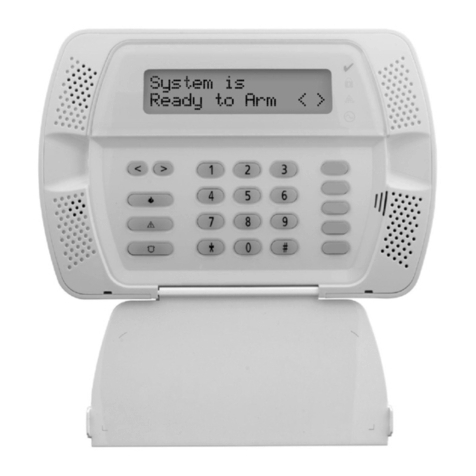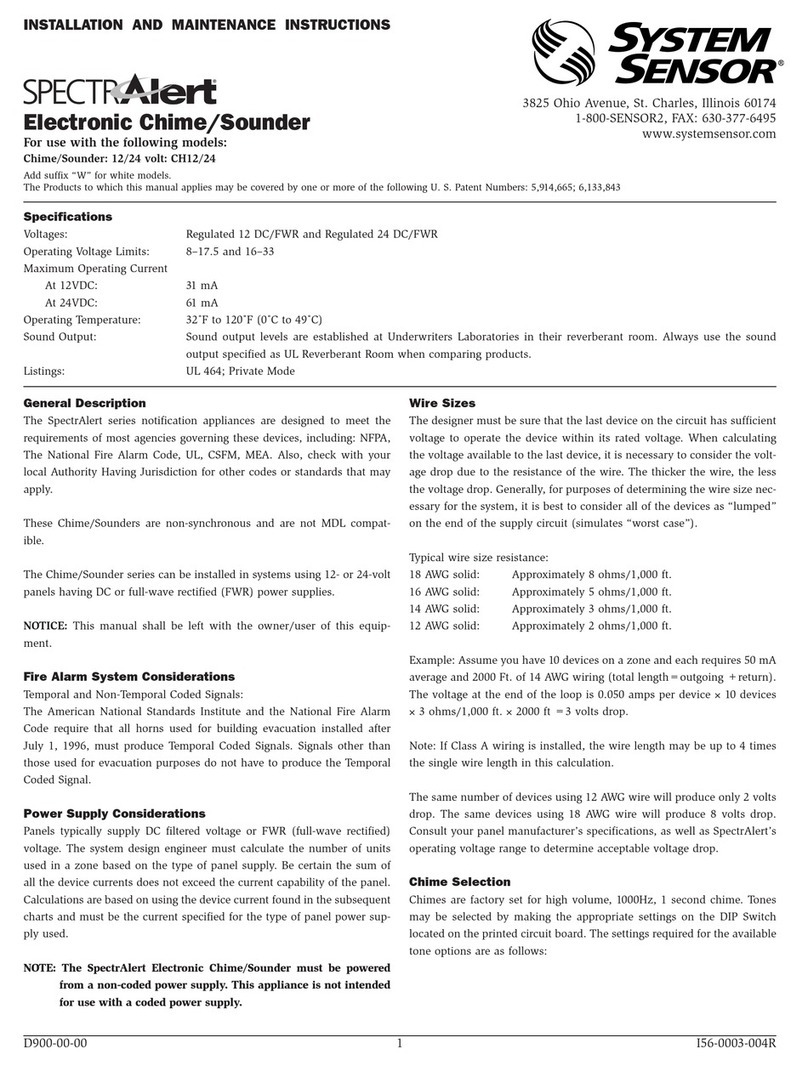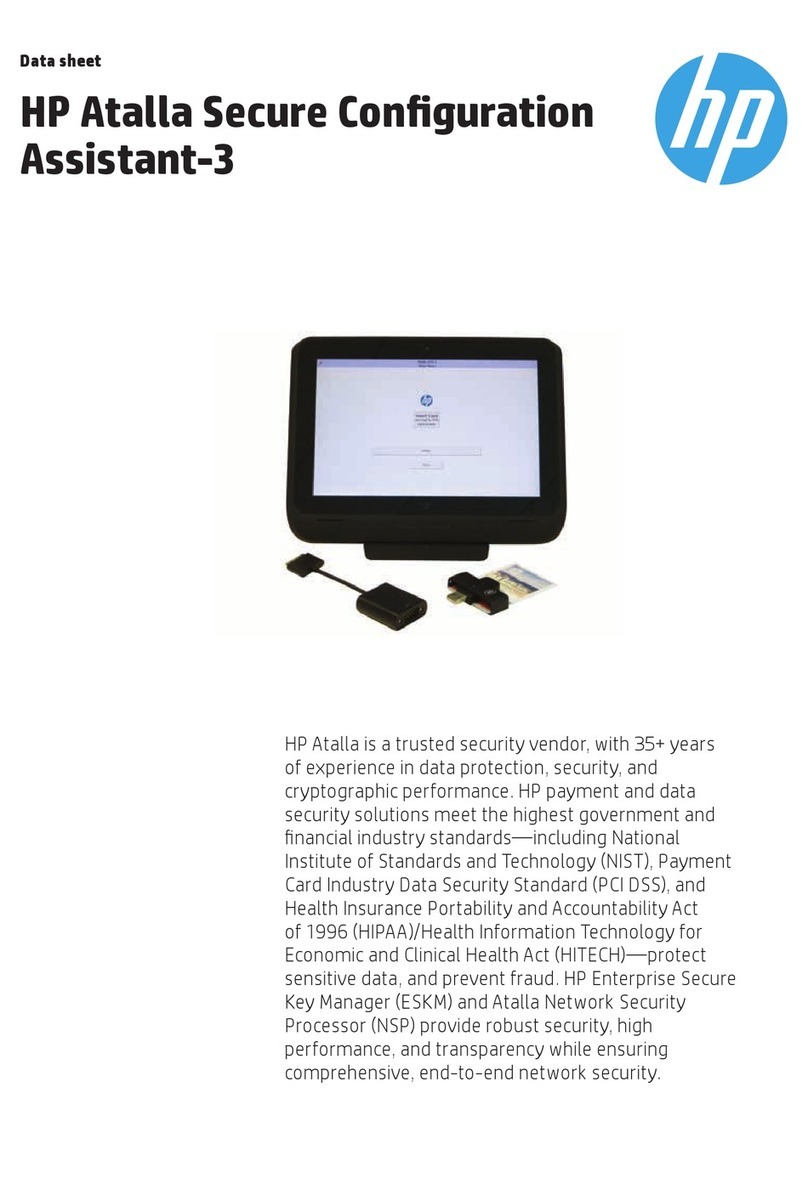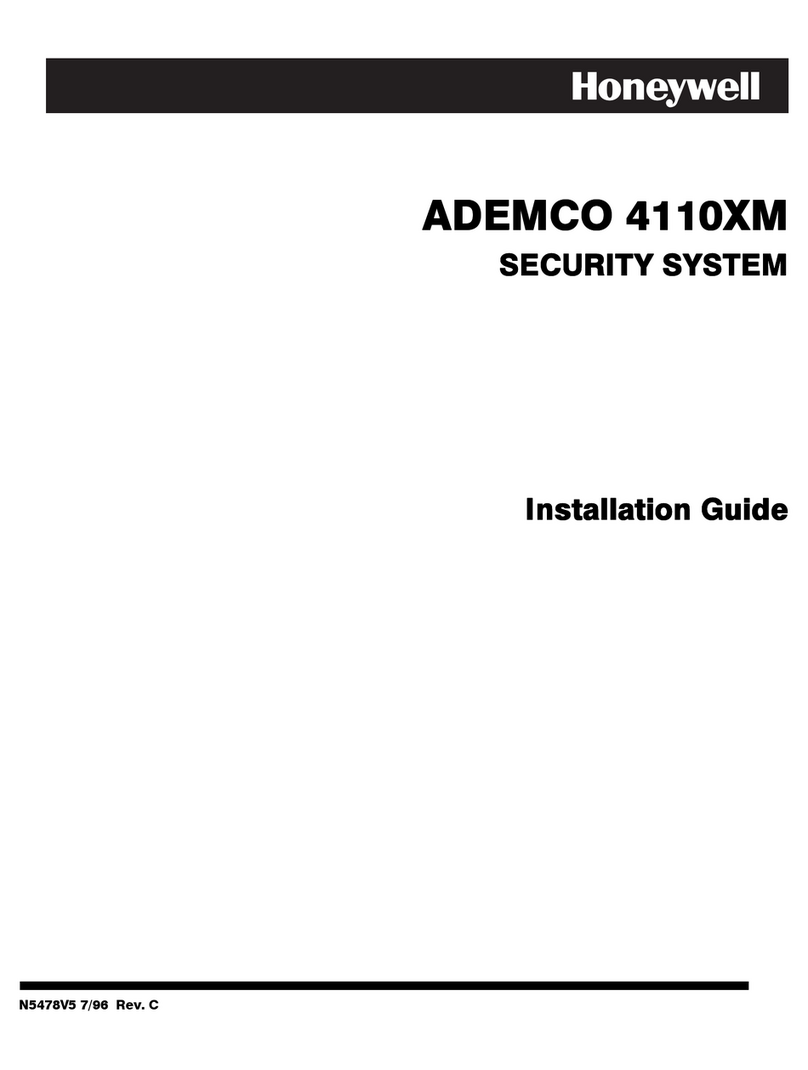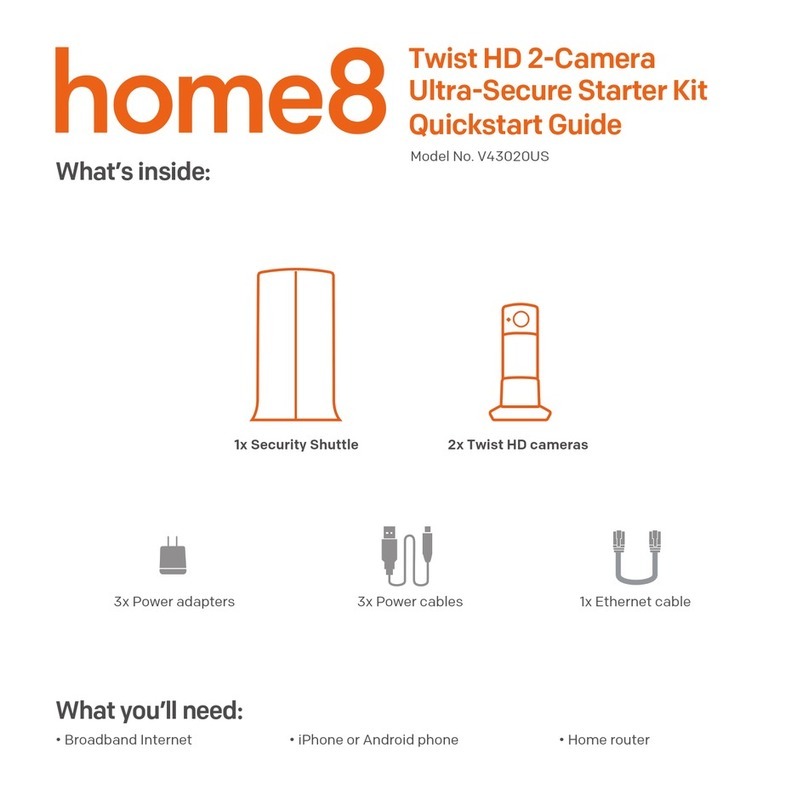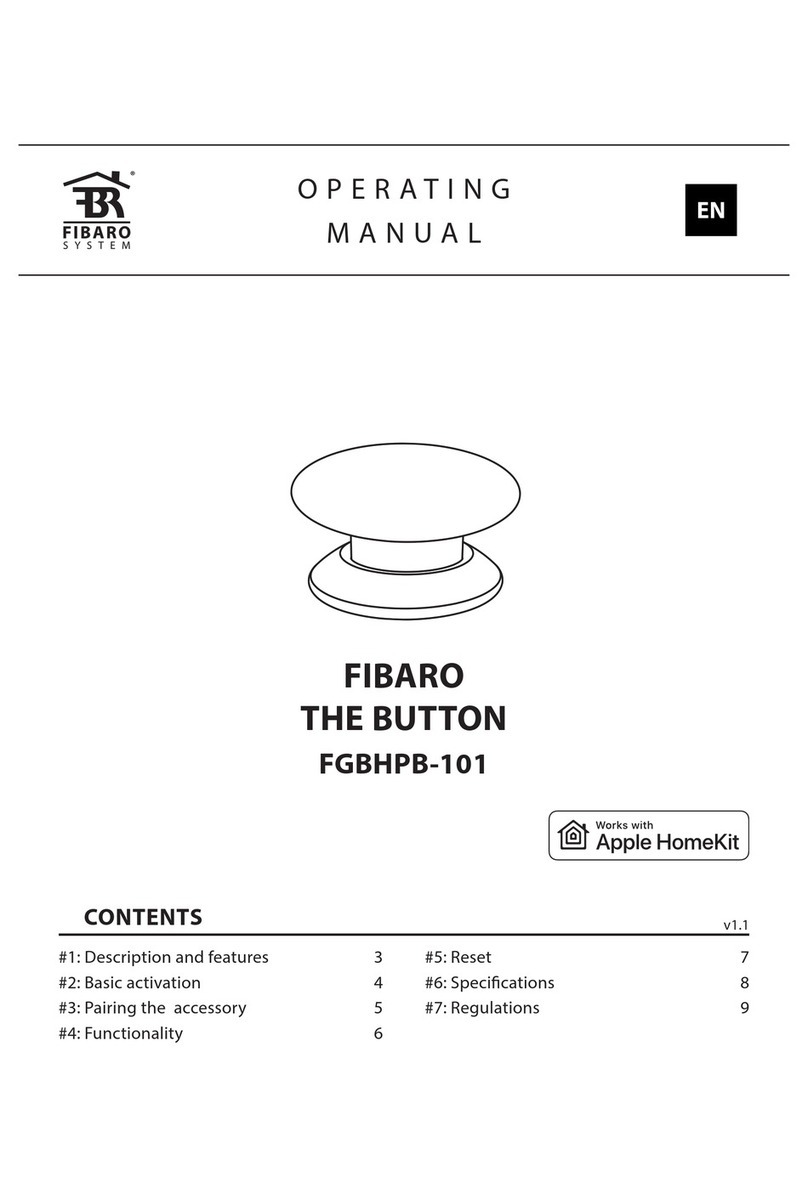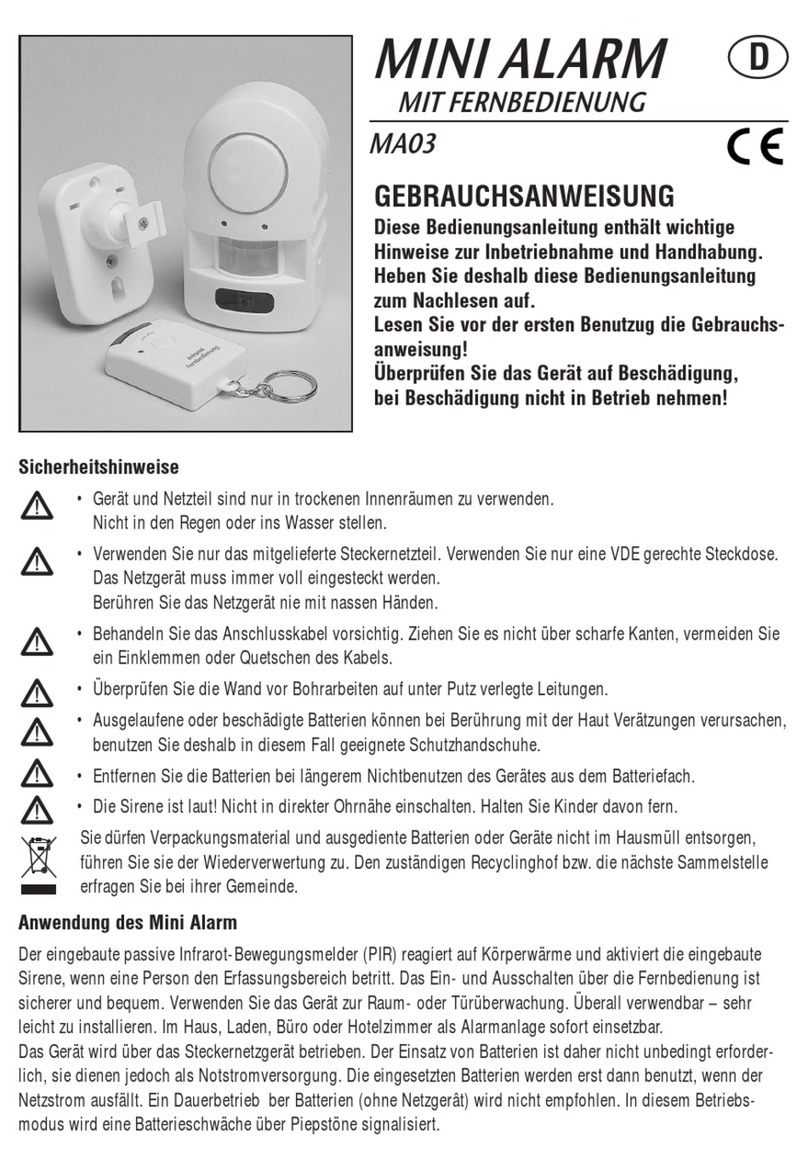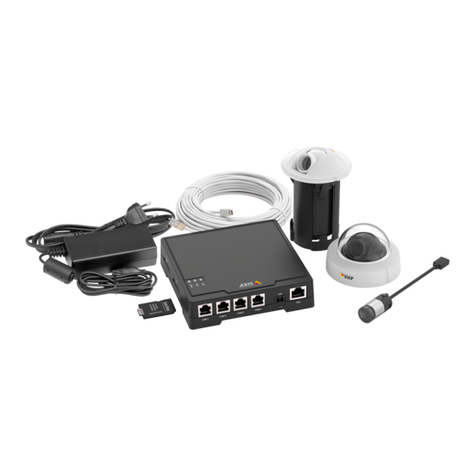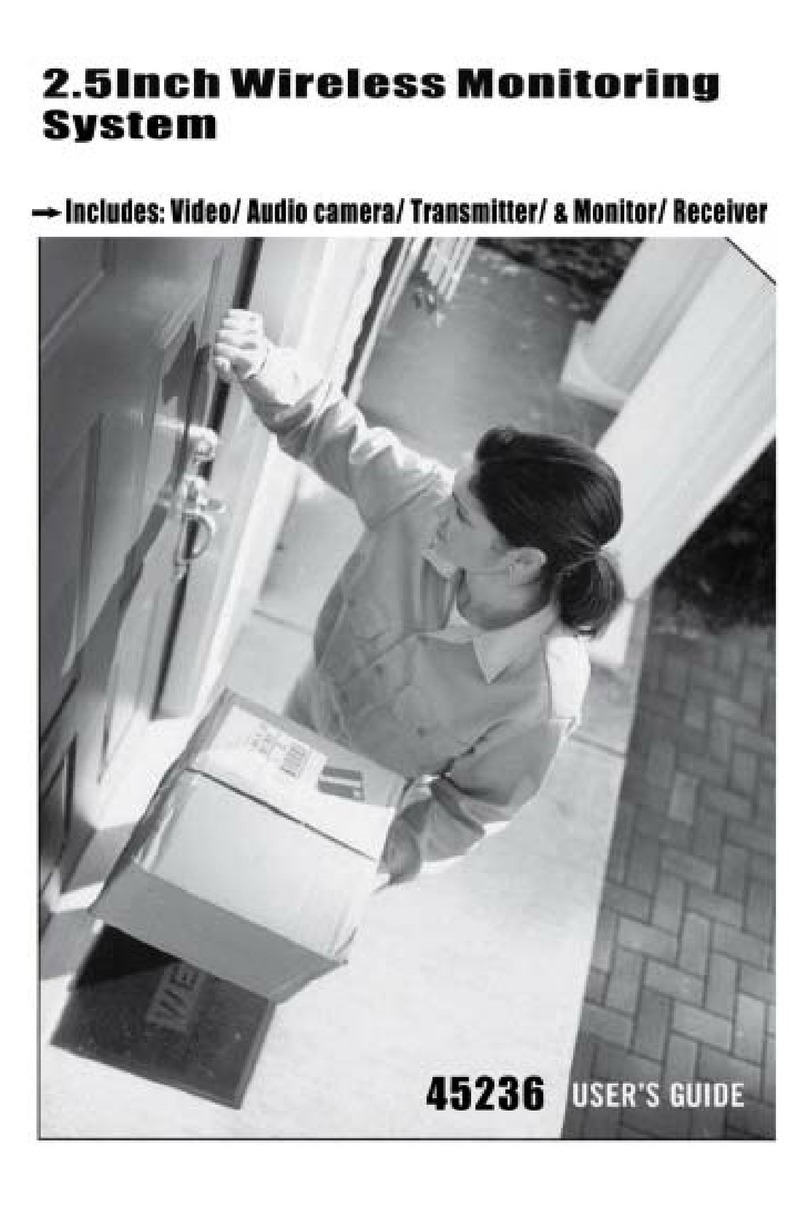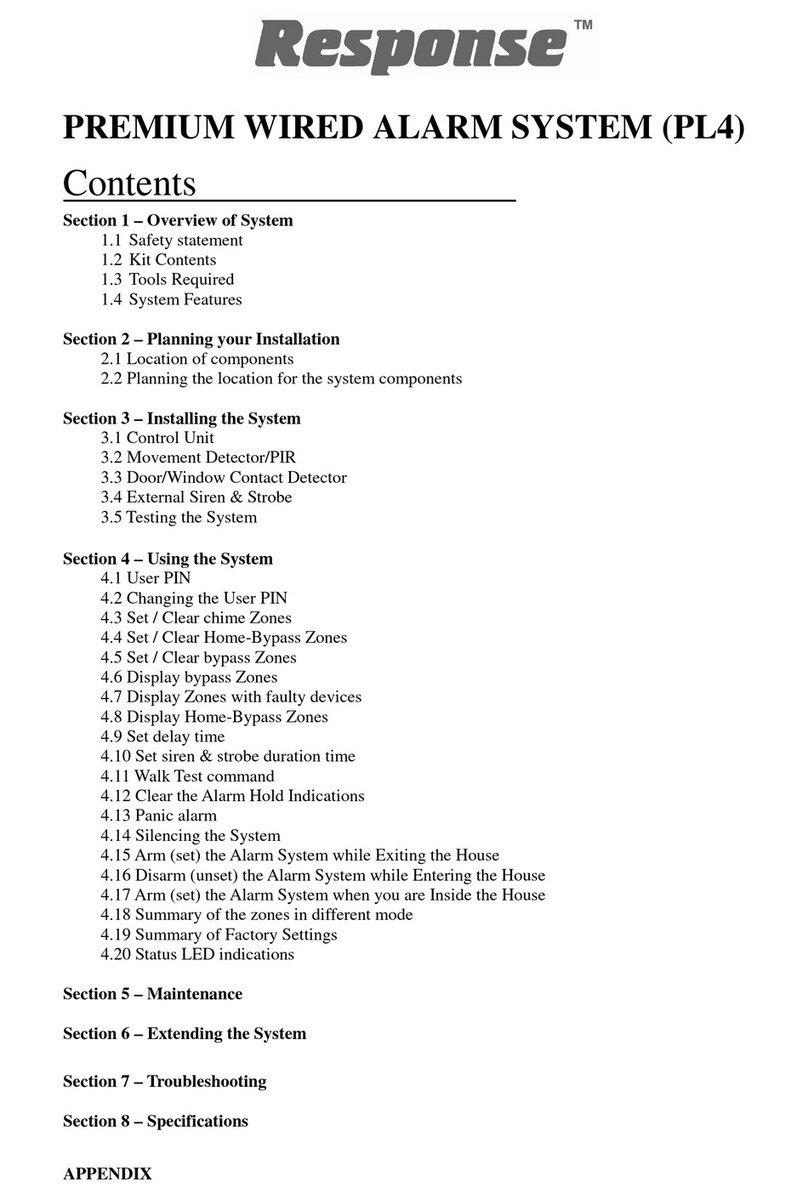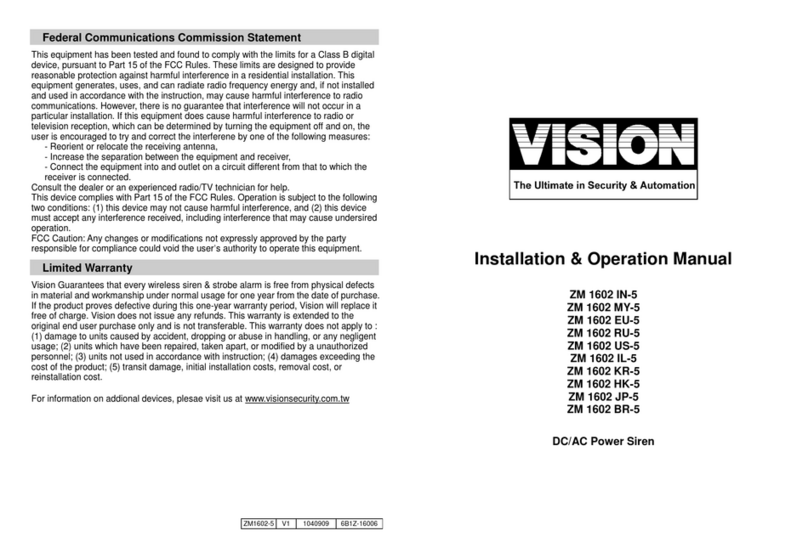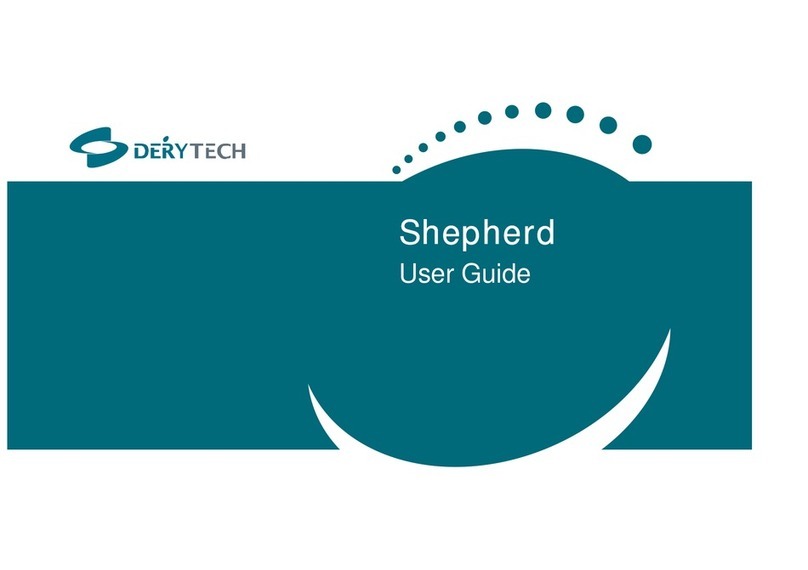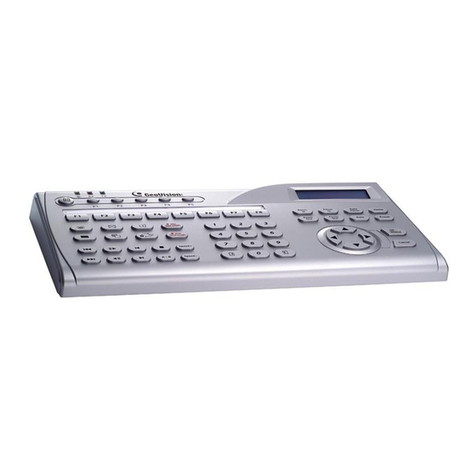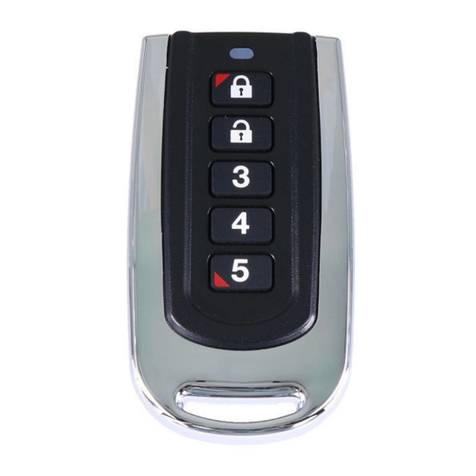Telguard TG-4 User manual

56050301 – Rev B i© 2017 Telguard
TELGUARD®DIGITAL
TG-4
RESIDENTIAL & SMALL BUSINESS
CELLULAR ALARM COMMUNICATOR
INSTALLATION AND OPERATING
INSTRUCTIONS
Revised August 17, 2017
PROPRIETARY INFORMATION For use by TELGUARD®customers only.
Distribution to others strictly prohibited.
Note: The registration form must be completed before leaving for the installation site. The
registration form may be completed online through our 24/7 dealer portal www.telguard.com.
FOREWORD
Dealers purchase Telguard®cellular communicatorsfor the quality, features and total value they
represent. The Telguard model TG-4 (p/n TG4LA002) is UL Listed for Household Fire systems,
Household Burglary systems and Miscellaneous Supplemental Use. This means that the TG-4 may

56050301 – Rev B ii © 2017 Telguard
be used in Household Burglarysystems, Household Fire systemsor combined Household Burglary
& Fire system as the primary or secondary communication path.
TECHNICAL SUPPORT
Technical support for all Telguard products is available:
Monday -Saturday 8am -8pm ET
Toll Free: 800-229-2326, option 9
ABOUT THIS MANUAL
This manual assumes that you have basic security system installation skills such asmeasuring
voltages, stripping wire, properly connecting wirestogether, connecting wires to terminals, and
checking phone lines. It also assumes that you have a familiarity with the proper installation and
programming tasks related to various alarm panels.
The material and instructions covered in this manual have been carefully checkedfor accuracy and
are presumed to be reliable. However, Telguard assumes no responsibility for inaccuracies and
reserves the right to modify and revise this manual without notice.
It is our goal at Telguard to always supply accurate and reliable documentation. If a discrepancy is
found in this documentation, please mail or fax a photocopy of the corrected material to:
Telguard Technical Services
3225 Cumberland Blvd, Ste 300
Atlanta, GA USA 30339
Fax: 678-945-1651
© 2016 Telguard. Atlanta, GAU.S.A. All rights reserved.
TELGUARD® is a registered trademark. Products are protected under one or more of the following
U.S. patents:
4,658,096
4,737,975
4,775,997
4,868,519
4,922,517

56050301 – Rev B iii © 2017 Telguard
FCC NOTICES
EXPOSURE TO RADIO FREQUENCY ENERGY
In 1991, the Institute of Electrical and Electronics Engineers (IEEE), and in 1992, the American
National Standards Institute (ANSI), updated the 1982 ANSIStandardfor safetylevels with respectto
human exposure to RF energy. Over 120 scientists, engineers and physiciansfrom universities,
government health agencies and industry, after reviewing the available body of research, developed
this updated Standard. In March 1993, the U.S. Federal Communications Commission (FCC)
proposed the adoption of this updated Standard.
The design of your Telguard complies with thisupdatedStandard. Of course, if you want to limit RF
exposure even further than the updated ANSI Standard, you may choose to install the unit in a
manner that locates its antenna at an even greater distance from the general public than is
recommended as a minimum by the standard.
To ensure compliance with the standard, when selecting a mounting locationfor your Telguard do
not mount it (or its associated antenna) in an area where the general public could reasonably be
within 8 inches (20 centimeters) of the antenna.
NOTICE: This device complies with Part 15 of the FCC Rules. Operation is subject to the following
two conditions:
This device may not cause harmful interference.
This device must accept any interference received, including interference that may cause
undesired operation.
NOTICE: Changes or modifications made to this equipment not expressly approved by Telguard
Corporation may void the FCC authorization to operate this equipment.
EFFICIENT OPERATION
Do not operate your Telguard product when holding the antenna. Be suretomount the unit such that
its antenna is kept a minimum of eight (8) inches (20 centimeters) from the general public.
For the best service quality:
Keep the antenna free from obstructions and point the antenna straight up.
Do not mount the unit or antenna in the basement or below ground.
ANTENNA CARE AND REPLACEMENT
Do not use the unit with a damaged antenna. If a damaged antenna comes into contact with the
skin, a minor burn may result. Have your antenna replaced by aqualified technician immediately.
Use only a manufacturer-approved antenna. Non-approved antennas, modifications, or attachments
could impair service quality, damage the Telguard and violate FCC regulations.
ELECTRONICDEVICES
Most modern electronic equipment is shieldedfrom RF energy. However, RF energy from cellular
devices may affect inadequately shielded electronic equipment. RF energy may affect improperly
installed or inadequately shielded electronic equipment operating in homesand businesses. Check
with the manufacturer or its representative to determine if these systems are adequately shielded

56050301 – Rev B iv © 2017 Telguard
from external RF energy. Consult the manufacturer of any personal medical devices (such as
pacemakers, hearing aids, etc.) todetermine if theyare adequately shieldedfrom external RF
energy.
NOTICE: This equipment has beentested and found to comply with the limits for a Class B digital
device, pursuant to Part 15 of the FCC Rules. These limits are designed to provide reasonable
protection against harmful interference in a residential installation. This equipment generates, uses
and can radiate radio frequency energy and, if not installed and used inaccordance with the
instructions, may cause harmful interference to radio communications. However, there is no
guarantee that interference will not occur in a particular installation. If this equipment does cause
harmful interferenceto radio or television reception, which can be determined by turning the
equipment off and on, theuser is encouraged to try to correct the interference by one or more of the
following measures:
Reorient or relocate the receiving antenna.
Increase the separation between the equipment and receiver.
Connect the equipment into an outlet on a circuit different from that to which the receiver is
connected.
Consult the dealer or an experienced radio/TV technician for help.
BLASTINGAREAS
To avoid interfering with blasting operations, turn OFF your unit when in a “blasting area” or in areas
posted: “Turn off two-way radio.” Construction crews often use remote controlRF devices to set off
explosives.
POTENTIALLYEXPLOSIVEATMOSPHERES
TurnOFF your unit when in any area with a potentially explosive atmosphere. It israre, but your
Telguard Digital or its accessories could generate sparks. Sparksin such areas could cause an
explosion or fire resulting in bodilyinjury or even death. Areas with a potentially explosive
atmosphere are often, but not always, clearly marked. They include fueling areas such as gas
stations; below deck on boats; fuel or chemicaltransfer or storagefacilities; areas where the air
contains chemicals or particles, such as grain, dust, or metal powders; and any other area where you
would normally be advised toturn off your vehicle engine.
Do not transport or store flammable gas, liquid or explosives in the area where your Telguard Digital
or its accessories are located.
Vehicles using liquefied petroleum gas (such as propane or butane) must comply with the National
Fire Protection Standard(FPA-58). For a copy of this standard, contact the National Fire Protection
Association, http://www.nfpa.org/.
REPAIR AND WARRANTY
If trouble is experienced with the Telguard Cellular Alarm Communicator please contact
Telguard Technical Support for trouble shooting, repair and (or) warranty information. The
dealer or enduser should not attempt any repair to the TelguardCellular Alarm
Communicator. Repair of this equipment should only be referred to qualified technical
personnel.

56050301 – Rev B v© 2017 Telguard
Telguard will repair or replace (our option) inoperative unitsfor up to two years from date of
manufacture. This excludes damage due to lightning or installer error. Unauthorized modifications
void this warranty. Telguard is not responsible for incidental or consequential damages. Liability is
limited to the price of the unit. This is the exclusive warranty and no other warranties will be honored,
whether expressed or implied.
An RMA must be assigned before returning product. Youmay obtain an RMA via phone
at 800-229-2326 option 1, or via email at returns@telguard.com.
Note: RMA number must be on the outside of box or product will not be accepted.
FUTURE TESTING AND LIMITATIONS ON USE
Telguardispart of an advanced designalarm-communication system. It does not offerguaranteed
protection against burglary and fire. Any alarm communication system is subject to compromise or
failure.
The Telguardwill not work without power. Electrically powered devices will not work if the power
supply (AC or DC) is off for any reason, however briefly.
The cellular radio network, needed to transmit alarm signals from protected premises to a central
monitoring station, could become inoperable or temporarily out of service. Cellular radio networks
are also subject to compromise bysophisticated methods of attack.
This equipment, like any other electrical device is subject to component failure. Although this
equipment is designed tobe long lasting, the electrical components couldfail at any time.
Due tothese limitations, we recommend that if the automatic self-test feature is not enabled, other
arrangements bemade with the user to test the system at least once every three months. Moreover,
arrangements should also be madefor on-site inspection/test by a licensed alarm installer at least
once each year.

56050301 – Rev B vi © 2017 Telguard
TERMS AND CONDITIONS FOR USE OF TELGUARD PRODUCT
These Terms and Conditions are a legal contract between you and Telguard for the title to and use
of the Product. BY RETAINING AND USING THE PRODUCT YOU AGREE TO THE TERMS
AND CONDITIONS INCLUDING WARRANTY DISCLAIMERS, LIMITATIONS OF LIABILITY AND
INDEMNIFICATION PROVISIONS BELOW. IF YOU DO NOT AGREE TO THE TERMS AND
CONDITIONS, DO NOT USE THE PRODUCT AND IMMEDIATELY RETURN THE UNUSED
PRODUCT FOR A COMPLETE REFUND. You agree to accept sole responsibility for any misuse
of the Product by you; and, in addition, any negligent or illegal act or omission of your or your
agents, contractors, servants, employees, or other users of the Product so long as the Product was
obtained from you, in the use and operation of the Product.
INDEMNIFICATION OFTELGUARD
YOU SHALL INDEMNIFY, DEFEND AND HOLD HARMLESS TELGUARD FOR ANY OF THE
COST, INCLUDING REASONABLE ATTORNEYS’ FEES, AND FROM CLAIMS ARISING OUT
OF YOU, YOUR CLIENTS’ OR OTHER THIRD PARTIES’ USE OR OPERATION OF THE
PRODUCT: (i) FOR MISUSE OR IN A MANNER NOT CONTEMPLATED BY YOU AND
TELGUARD OR INCONSISTENT WITH THE PROVISIONS OF THIS MANUAL; (ii) IN AN
ILLEGAL MANNER OR AGAINST PUBLIC POLICY; (iii) IN A MANNER SPECIFICALLY
UNAUTHORIZED IN THIS MANUAL; (iv) IN A MANNER HARMFUL OR DANGEROUS TO
THIRD PARTIES; (v) FROM CLAIMS BY ANYONE RESPECTING PROBLEMS, ERRORS OR
MISTAKES OF THE PRODUCT; OR (vi) COMBINATION OF THE PRODUCT WITH MATERIAL,
MODIFICATION OF THE PRODUCT OR USE OF THE PRODUCT IN AN ENVIRONMENT NOT
PROVIDED, OR PERMITTED, BY TELGUARD IN WRITING. THE PARTIES SHALL GIVE EACH
OTHER PROMPT NOTICE OF ANY SUCH COST OR CLAIMS AND COOPERATE, EACH WITH
THE OTHER, TO EFFECTUATE THIS INDEMNIFICATION, DEFENSE AND HOLD HARMLESS.
WARRANTY;LIMITATIONS
TELGUARD WILL REPAIR OR REPLACE (OUR OPTION) INOPERATIVE UNITS FOR UP TO
TWO YEARS FROM DATE OF MANUFACTURE. EXCLUDES DAMAGE DUE TO LIGHTNING
OR INSTALLER ERROR ASWELL AS UNITS THAT INCORPORATE MATERIAL, OR USED IN
A MANNER OR ENVIRONMENT, NOT SPECIFICALLY AUTHORIZED IN THIS MANUAL.
UNAUTHORIZED MODIFICATIONS VOID THIS WARRANTY. NOT RESPONSIBLE FOR
INCIDENTAL OR CONSEQUENTIAL DAMAGES. LIABILITY LIMITED TO PRICE OF UNIT.
THIS IS THE EXCLUSIVE WARRANTY, IN LIEU OF ALL OTHERWARRANTIES INCLUDING
IMPLIED WARRANTIES OF MERCHANTABILITY, TITLE, DELIVERY, INFRINGEMENT OR
FITNESS FOR A PARTICULAR PURPOSE AND NO OTHER WARRANTIES WILL BE
HONORED, WHETHER EXPRESSED OR IMPLIED.

56050301 – Rev B vii © 2017 Telguard
TABLE OF CONTENTS
Foreword..............................................................................................................................i
Technical Support..............................................................................................................ii
About this Manual..............................................................................................................ii
FCC Notices.......................................................................................................................iii
Repair and Warranty.........................................................................................................iv
Terms and Conditions for Use of Telguard Product .....................................................vi
Table of Contents.............................................................................................................vii
General Description and Operation .................................................................................1
Features..............................................................................................................................1
Operating Mode.......................................................................................................................... 1
Multiple Alarm Format Support................................................................................................. 1
Complete Supervision of Communication Path ...................................................................... 2
Complete Power Supervision.................................................................................................... 3
Telguard Automatic Self-test Report........................................................................................ 4
Telguard Remote Query Capability........................................................................................... 4
Programmable Supervisory Trip Output (STC) Relays........................................................... 5
Diagnostic and Status LEDs...................................................................................................... 5
DC Operation (Panel Power)...................................................................................................... 5
COMPLETE FACTORY RESET OPTION................................................................................... 6
UL Listings.................................................................................................................................. 6
Getting Ready.....................................................................................................................7
Dealer Account Establishment.................................................................................................. 7
Pre-Installation Checklist........................................................................................................... 7
Installation..........................................................................................................................8
Summary..................................................................................................................................... 8

56050301 – Rev B viii © 2017 Telguard
Step 1: Register the Telguard Unit............................................................................................ 8
Step 2: Locate Unit and Measure Signal Strength (RSSI)....................................................... 9
Step 3: Verify Panel Alarms Over the Telco Connection ...................................................... 11
Step 4: Activate & Transmit Alarms over Cellular Network.................................................. 11
Step 5: Connect Supervisory Trip Outputs............................................................................ 14
Step 6: Connect and Test the Trip Input (optional)............................................................... 15
Step 7: Complete the Telguard Installation........................................................................... 15
Appendix 1 – Connection Guide.....................................................................................16
Wiring Diagram......................................................................................................................... 16
Jack Assignments.................................................................................................................... 17
Main Terminal Strip Pin Assignments.................................................................................... 17
AC Terminal Strip Pin Assignments....................................................................................... 18
Compatible Alarm Panels........................................................................................................ 18
Appendix 2 – Troubleshooting Guide............................................................................18
Troubleshooting Quick Reference Table................................................................................ 21
Appendix 3 – Detailed Specifications............................................................................21
Dialer to Interface Electronics................................................................................................. 21
Power ........................................................................................................................................ 22
Digital Cellular Radio ............................................................................................................... 22
Appendix 4 – Parts List ...................................................................................................23

56050301 – Rev B 1© 2017 Telguard
GENERAL DESCRIPTION AND OPERATION
The Telguardmodel TG-4 is a digital cellular radio alarm transmission device used to provide a
primary or back-up transmission path (cellular) for alarm panels. Depending on the TG-4
configuration (determined at time of installation), the alarm panel will use the PSTN line or cellular
as primary or back-up (secondary) transmission path to deliver alarm messages. When it is
configured as a backup, it will provide transparent access from the alarm panel to the central
station. When transmitting an alarm signal using the cellular path, the Telguard obtains its data
from the alarm panel by way of a Telco line interface. The Telguard will obtain all alarm signal
information including monitoring station phone number, account number and all zones for every
alarm transmission. The Telguard handshakes with the alarm panel causing it to transmit the alarm
data. The Telguard encodes the alarm data and transmits to the Telguard Communication Center
(TCC) over the digital cellular network. The TCC performs a function similar to a central station
receiver and issues the transmission acknowledgement when the last message in the transmission
is received. After decoding and reformatting, the alarm signal is routed to the appropriate alarm
company monitoring station for action.
In a cellular back up alarm installation, the incoming Telco line is connected from the premises’ RJ-
31x jack to the Telguard and then from the Telguard's RJ-45 jack to the alarm panel. Two
programmable System Trouble Condition (STC) relays provide supervisory trip outputs for
connection to the alarm panel’s trip zone input terminals in order to provide a Telguard trouble
signal to the alarm panel. Additionally, automatic self-test and remote query signals are
transmitted exclusively over the cellular network with all Telco line and cellular monitoring,
switching and supervisory functions built in. No extra modules are required. The Telguard TG-4
has its own power supply which keeps the Telguard battery charged. In addition, the TG-4 has an
optional connection to receive its operating power from the host alarm panel (eliminating the need
for the adapter/battery connections).
The UL Listed equipment at the TCC plays a key role in the operation of every Telguard. All
Telguard units utilize the TCC due to the panel alarm signal format encoding and decoding
requirements used in packet-data transmissions over the digital cellular network. The TCC also
manages the real-time databases for cellular accounts and a complete history of every Telguard’s
operating conditions. These conditions include programming setup information, cellular alarm
transmission information, supervisory trouble information, remote query information, and automatic
self-test information.
FEATURES
This section summarizes the key features of the Telguard TG-4.
OPERATING MODE
The Telguard is a digital cellular data/SMS transmission device that is installed at the protected
premises to provide alarm transmission for security systems. The Telguard TG-4 transmits alarm
signals over the nationwide digital cellular network if the telephone line or data network has been
disrupted, compromised or when there is no wire line service available.
MULTIPLE ALARM FORMAT SUPPORT
Telguard TG-4 default program setting is for Auto Detection of the panel alarm format. Auto Format
Detect feature allows the Telguard to adapt to receive any listed format on every alarm

56050301 – Rev B 2© 2017 Telguard
transmission. If the alarm format is changed for whatever reason, the Telguard will sense the new
format and accept the alarm signal.
In order for the alarm panel to be compatible with the Telguard, the alarm panel must be
programmed to transmit alarm messages to the central station using one of the following non-
extended formats:
Pulse Formats:
o3+1 pulse; 10pps, Double Round, 1400Hz ack
o3+1 pulse; 20pps, Double Round, 2300Hz ack
o3+1 pulse; 40pps, Double Round, 2300Hz ack
o4+2 pulse; 20pps, Double Round, 1400Hz ack
o4+2 pulse; 20pps, Double Round, 2300Hz ack
o4+2 pulse; 40pps, Double Round, 2300Hz ack
Contact ID
Radionics Modem IIe/IIIa2/4
SIA2 (SIA-DC-03 level 2 release at 300 baud)
DMP
Hexadecimal account numbers can be used with 3+1 or 4+2formats, as well as Contact ID (4 or 10
digits) and Modem IIe, IIIa2, or 4 (4 digits).
COMPLETE SUPERVISION OF COMMUNICATION PATH
The Telguard TG-4 continuously supervises boththe Telco and cellular communication paths. If
either communication path becomes inoperative, the Telguard generates a relay trip output that can
be connected toa zone input of the host alarm panel and/or usedto control remote annunciation
devices.
STANDARD LINE SECURITY
The Telguard TG-4 meets the requirements for Standard Line Security(equivalent to previously
known AA Grade security) when used with a UL Listed compatible alarm panel and when monitored
using the 200-second Supervision cellular service plan. The 200-second supervision is required to
meet Standard Line Security. Once theTG-4 model is provisioned with the 200-second supervision,
the TCC constantly monitors the cellular path and sends a specific message to the central station if
the path is broken. After the initial account activation is done, the installer must verify the Standard
Line Security by turning off the device for 200 seconds and making sure an alarm with the specific
code is delivered to the central station.
WARNING: Standard Line Security has only been evaluated between the TG-4 and the
TCC. It is the responsibility of the installer to verify Standard Line Security from the Listed
control unit to the Listed receiver through the TG-4 as marked on the alarm panel and as
indicatedin the control unit manufacturer's installation instructions.
LINE FAULT CONDITION (LFC)
The Telguard monitors voltage on the incoming Telco line. If an inoperative Telco line is identified,
(voltage below –20vdc, on hook) a Telco line fault condition (LFC) is declared. The System Trouble
Condition LED (STC LED) will flash 3 times and the STC relay will trip after a programmable delay of
30 or 60 seconds. Upon Telco restoral, the relay and STC LED are returned to normal.
NOSERVICE CONDITION (NSC)

56050301 – Rev B 3© 2017 Telguard
The Telguard declares a no service condition (NSC) when the Telguard device is unable to register
with the cellular network.
NSC is programmable to trip the supervisory relay output (STC relay) after a variable period of
time. The STC LED will flash 4 times immediately after losing cellular service and independent of the
STC assertion and programmed assertion delay. NSC restoral occurs immediately after cellular
service has been acquired.
RADIO COMMUNICATIONS FAILURE CONDITION (RFC)
Radio communications failure condition (RFC) is declared when the Telguard is unable to transmit
over the cellular network even with acceptable signal strength. When RFC is declared, the STC LED
will flash 5 times and the STC relay will trip as programmed. RFC isrestored when communication
with the TCC is restored.
PANEL PRESENCE FAILURE (PPF)
Panel presence failure condition (PPF) is declared when the Telguard is unable to detect the
presence of the alarm panel. PPF is indicated by the STC LED flashing 7 times. PPF is restored
immediately after the connection to the panel is restored and maintained for the delay period.
NOTE: The factory default for PPF is Disabled and needs to be Enabled for its use. In order
for the PPF feature to work, Tip, Ring, and the return connections for Tip and Ring must be
connected between thepanel and the Telguard.
CONTROL FAILURE TO COMMUNICATE (CFC)
The Control Failure to Communicate(CFC) feature is an option that allows the Telguard unit to
monitor the number of communication attempts the alarm panel makes over Telco before the
Telguard becomes the main path of communication. This feature works bymonitoring the alarm
panel from the time it goes off-hook, and attempts to communicate, to on-hook status, and comes off-
hook again. Each changein state by the alarm panel from off-hook to on-hook to off-hook again is
considered an attempt. If this continually happensfor a specified number of times within a specific
time period, then the Telguard seizes the line and takes over as the main communication path for the
alarm panel. If the Telguard goes into CFC, then it will not allow the panel tocommunicate via Telco
again until the panel has been on-hook for 10 consecutive minutes.
Note that the CFC condition causes the Telguard unit to redirect communications to the cellular
channel, but it is not indicated on the STC LED, nor does it cause either of the external relays to be
tripped.
NOTE: The factory default for CFC is Disabled and needs to be Enabled for its use. When the
TG-4 is configured as a Cellular-Only solution, the CFC functionis not applicable.
COMPLETE POWER SUPERVISION
The Telguard supervises and reports status of the backup battery and AC power source. The
Telguardhas an integrated control and power module which also keeps the Telguard battery charged
and performs a battery load test every 24 hours. This battery charger function is also supervised.
LOW/MISSING BATTERY CONDITION (LBC)
The Telguard checks the backup battery voltage on initial power-up and every 60 seconds thereafter.
If the battery voltage is less than 11.6 volts,the battery state will change from ‘good’ to ‘bad’ leading
to declaration of an LBC whereby the STC LED blinks twice, and the STC relay trips. When the

56050301 – Rev B 4© 2017 Telguard
battery voltage increases to 12.1 volts, the STC LED and STC relay restore. The Telguard also
indicates Low/missing Battery Condition (LBC) when the battery charger fails or when the battery
load test fails.
AC FAILURE CONDITION (ACFC)
AC failurecondition (ACFC) is detected immediately when the AC power drops below 102 VAC.
When this condition is detected, the STC LED blinks once, the AC Power LED turns off, and the STC
trip output is activated after 2 hours. When AC power returns to normal (106 VAC), the AC Power
LED turns on immediatelyand the STC trip output restores after 60 seconds.
NOTE: If the Telguard is being powered through its DC connection, a Low Power Failure (LPF)
will occur if the DC power drops below 5.1VDC and restore after reaching >5.6VDC. LPF will
present itself in the same manner as the ACFC.
DIAL TONE FAILURE (DTF)
The Telguard continuously monitors the subscriber line interface circuit that provides dial tone to the
alarm panel. ADialTone Failure (DTF) is declaredwhen the line interface while the alarm panel is
on-hook. The STC LED will flash 6 times and the STC relay will trip.
Note: This condition will require contacting Telguard Technical Support for resolution.
CATASTROPHIC FAILURE (CF)
Catastrophic Failure(CF) is any condition that causes the Telguard to stop functioning at all levels.
The most common cause for CF is AC power failure followed by a complete discharge of the backup
battery. The STC1 and STC2 trip outputsare activated and the visible indication is loss of all LED
activity. Total loss of power to the Telguard does not prevent transmission of alarm messages from
the alarm panel “through” the Telguard and out over an operative phone line. If power is connected
properly to the unit when a CF occurs, please contact Telguard Technical Supportfor resolution.
TELGUARD AUTOMATIC SELF-TEST REPORT
The automatic self-test signal is programmed to a daily, weekly or monthly schedule as prescribed
when the Telguard is registered. The central station receives the automatic self-test report in the
sameformatthat thealarm panel normally uses for communication over the Telco line. The self-test
code andtesting frequencyare set during registration, and can accommodate anycode the Central
Station expects. The TCC captures all current and historical data pertaining to the operation of the
Telguard when it processes the automatic self-test signal. This data contains current operational
status (C.O.S.) of the Telguard such as "All OK", "AC fail condition", "low/missing battery condition",
or any combination of these as well as the current signal strength. In addition, the data also contains
historical data for supervisory events that occurred since the last self-test or remote query report
signal was transmitted. This data includes the number of occurrences of AC fail conditions, low
battery conditions, line fault conditions, communications failure conditions and no cellular service
conditions. This additional information is available by contacting Telguard Technical Support or by
visiting www.Telguard.com (dealer log-in credentials required).
TELGUARD REMOTE QUERY CAPABILITY
Although theTelguard has the capability for a daily, weekly, or monthly automatic self-test, a
separatefeature is provided for determining the current operational status of every Telguard. This
feature is called Remote Queryand is usedto provide real-time operationalstatusfor the Telguard
on-demand. It is useful in resolving STC events thatare reported by the alarm panel to the central
station. The Remote Query is available via www.Telguard.com. The Remote Query causes the

56050301 – Rev B 5© 2017 Telguard
Telguard to upload current operational status data and historical data, just as the automatic self-test
described above, except that the query signal is controlled by the one who initiates it. Thequery
signal is held in the Telguard database at the TCCfor review and is not forwarded on to the central
station.
PROGRAMMABLE SUPERVISORY TRIP OUTPUT (STC)RELAYS
The Telguard has two supervisory relay trip outputs (STC1 normally open and STC2 normally
closed) and both are energized in a powered-up state when no system troubles exist. This enables a
supervisory trouble code to be transmitted to the central station when connected to an alarm panel’s
24-hour instant input zone. The STC relays are programmable, using www.Telguard.com, to meet
virtually any installation requirement.
The following supervisory features or combination of features are programmable to trip the STC
relays in order to meet a variety of installation requirements:
Trips on AC fail condition (ACFC)—or Low Power Failure (LPF) if powered from a DC
source.
Trips on low or missing battery condition (LBC).
Trips on no service condition (NSC).
Trips on line fault condition (LFC).
Trips on radio communication failure condition (RFC).
Trips on dial tone failure(DTF)
The following system trouble features are embedded in the Telguard for tripping the STC relay and
cannot be changed:
Tripped when unit is not activated at the TCC
Trips on catastrophic failure (CF) if all power is lost.
Trips on transmit-disable command from the TCC. This radio command disables only the
Telguard transmitter and would be used, for example, to shut down the Telguard due to a
runaway dialer.
DIAGNOSTIC AND STATUS LEDS
Six active LEDs are provided as a useful aid during installation and give installers an immediate
visual indication of system status. The LEDs serve as indicators for activation, system trouble
conditions, AC power, and communication indicators. They can also be used to provide a signal
strength indication, similar to the signal strength bars on a cellular phone. See the installation
section for details.
DCOPERATION (PANEL POWER)
TG-4 can be operated solely by DC Power Source (for example, power coming from the alarm
panel’s auxiliary output). This will eliminate the need for a separate AC outlet at the protected
premises. Connect the panel power to DC Input and ground on the TG-4 and the TG will
operate normally. Telguard‘s operational range is 6.2V - 16V DC.
Note: When using DC power, the Telguard should not be connected to a battery or AC
power source. Because there is no AC connection, the AC LED will be OFF when operating
in DC mode. Battery will not charge on DC power.

56050301 – Rev B 6© 2017 Telguard
COMPLETEFACTORYRESET OPTION
A special function within the TG-4 allows you to perform a complete Factory Reset on the unit.
This reset will change all unit settings back to a factory default configuration.
Note: Never attempt to do a Complete Factory Reset on an active account.
To begin the factory reset, wait for the unit to initialize and hold down the RSSI button for 15
seconds. After 15 seconds, the LEDs will begin to sequentially turn on and off in a cascading
pattern. This is your indication that the factory reset is taking place. After the reset has concluded,
the LEDs will go back to normal status (deactivated, factory default configuration).
ULLISTINGS
Model TG-4 meetsthe requirements for all Household Burglary, Household Fire, and Combined
Household Burglary/Fire installations. It has a plastic enclosure and dipole antenna. TG-4 is UL
Listed for the following:
UL Household Burglary
UL Household Fire
UL Household Burg/Fire Combination
UL 365 and 1610 – Commercial Burglary*
Standard Line Security
*Not listed for Bank Vault or Safe Applications
UL Note: The compatible control unit must also be listed for the appropriate categories
listed above.

56050301 – Rev B 7© 2017 Telguard
GETTING READY
The Telguard can only be activated when all the necessary accounting information has been entered
into the customer database located at the TCC (i.e. the unit has beenregistered). The database
includes information about the customer account, unit location, and system test plan information.
DEALER ACCOUNT ESTABLISHMENT
A Dealer Account must be established prior to registration of any Telguard unit. This can be
accomplished by visiting www.telguard.com and completing the necessary information under “Dealer
Signup”. This is aone-time event and an acknowledgment fromTelguard Customer Service will
include a Dealer Account Number that will be used for all Telguard Digital registrations. Telguards
are available for registration and activation once the Dealer Account has been established.
PRE-INSTALLATION CHECKLIST
Before attempting to connect Telguardto the host alarm panel, please note the following:
Be sure you have all the proper parts before you go to the job site. The following itemsare shipped
with each Telguard:
Telguard Cellular Communicator
UL Listed plug-in transformer.
Cellular Antenna.
7-foot RJ45 plug to plug cord
Pluggable screw terminal blocks (2,3 & 6 position)
Quick Install Guide
Registration form
Note: The Telguard registration must be completed in advance to avoid installation delays
You must also have certain installation test tools:
Screws and a screwdriver will be required to attach the unit and antenna to the wall.
In order to connect the STC relay outputs and trip input to the alarm panel, solid or
stranded electrical wire will be required. The terminal strips can accommodate solid or
stranded wire from 14 to 22 gauge in size.
A standard telephone or lineman's butt-set is recommended for verifying communication
between the panel and the Telguard.

56050301 – Rev B 8© 2017 Telguard
INSTALLATION
SUMMARY
The following are steps necessary to install the Telguard properly.
NOTE: IF YOU DO NOT PROCEED IN THE ORDER AND MANNER PRESCRIBED, YOU MAY
NOT COMPLETE THE INSTALLATION IN THE TIME DESIRED.
These steps are summarized below and explained in detail in the remainder of this manual.
1. Register for Telguard service
2. Locate Unit and measure signal strength
3. Transmit an alarm over the Telco connection
4. Activate and transmit alarm panel alarms over the cellular connection
5. Connect supervisory trip outputs
6. Connect trip input (optional)
7. Complete installation
This seven-step installation approach provides the alarm installer with the easiest and fastest method
of properly installing yourTelguard TG-4. Pleasefollow the instructions carefully and if you should
need assistance or have anyquestions, call Telguard TECHNICALSUPPORT at 1-800-229-2326
extension 9.
STEP 1:REGISTER THE TELGUARD UNIT
Installation Tip: Register for Telguard service prior to leaving for the job siteto avoid a
second trip.
The registration form may be completed online through our 24/7 dealer portal www.telguard.com.
The desired features and programmable options for any installation are selected during the
registration process. This includes STC strategy, Trip-Input enabling, and added value services
like HomeControl Flex and Standard Line Security.
DECIDE ON A STC TRIP OUTPUT STRATEGY
The Telguard provides the host alarm panel with two supervisory trip outputsfor reporting a Telguard
system trouble code to the central station. The supervisory trip outputs are programmable to suit
various installation requirements. The programming options for these supervisory trip outputs can be
any combination of the following:
Always Off: Disables all relay supervisory functions.
ACFC: Trips 2 hours (programmable for up to 24 hours) after loss of AC power. Restores
60 seconds after AC power is restored.
LBC: Trips within 60 seconds on low battery condition. Restores when battery voltage
12.1 vdc.
LFC: Trips after 60 seconds on Telco line fault condition. Restores 60 seconds after Telco
line restores.
NSC: Trips after specified delay time (determined by POTS programming value 852) on no
service condition due to loss of RF signal strength. Restores after RF signal strength is
available.

56050301 – Rev B 9© 2017 Telguard
RFC: Trips on radio failure to communicate with the TCC
DTF: Trips on an internal failure in the dial tone circuitry within the TG-4
OPTIONAL TRIP INPUT
When the input is tripped, a supervisorymessage is sent to the central station via the TCC. This
allows an external relay, separate from the alarm panel, to be connected to the Telguard unit in
order to provide independent sensor input for other functions, such as tamper detection.
The message that is sent from the TCC to the central station is configurable in Telguard Online.
The TG-4 unit will automatically be configured with a unit template that allows configuration of the
trip input feature, including the message that is sent to the central station. There is a default event
configured for each alarm format, so that if the Telguard is configured with the butt-set to send trip
input events to the TCC, a default notification will be sent to the central station. If the Telguard is
configured to report restorals, the contact closure will also be reported.
SWINGER FUNCTION
The swinger function is designed to reduce the incidence of excessive messaging and alarms due
to faulty equipment or installation. If enabled, the swinger function will discontinue sending trip input
messages to the TCC once 10 trip events are detected within a 10 minute period. The Telguard
device will resume sending trip input messages to the TCC after a 10 minute period without trip
events.
STEP 2:LOCATE UNIT AND MEASURE SIGNAL STRENGTH (RSSI)
LOCATE UNIT
Temporarily place theTelguard unit near the alarm panel. Permanent mounting should only be done
after determining theoptimum cellular reception location.
CONNECT POWER
Option 1: Backup Battery and AC Power Transformer
To apply power to the Telguard using this option, attach a battery to the battery connector (labeled
BATT) or to the 3-pin terminal block labeled (BATT - +). Backup battery must be sized appropriately
to meet installation requirements. Pleasemake sure the battery wires are at least ¼ inch apart from
the other wiring in the system.
Connect the Telguard AC power transformer (see A3.2 for acceptable UL Listed transformers) to AC
terminals using strandedcopper insulated wire following wire gauge and length recommendations
below:
RecommendedWire Size LengthNot to Exceed
18 ga 20 ft
16 ga 40 ft
14 ga 60 ft
Option 2: DC power
To apply DC power to Telguardfrom a host alarm panel, connect the panel power and ground
connections into the respective DC and GND connections on the TG-4. When using this option, no
other power connections (battery or AC) should bewired.

56050301 – Rev B 10 © 2017 Telguard
CONNECT ANTENNA AND TEMPORARILY PLACE UNIT
The Telguard unit is supplied with an antenna. In most cases the antenna can be mounted directly to
the unit. If necessary, the antenna may be moved to a better signal location using optional cable and
bracket accessories. The performance of the antenna may be affected bythe wall or materials
contained within the wall chosen for mounting. These effects may not be clearly identified by RSSI
monitoring alone. The wall materials may have a more pronounced effect on the antenna transmit
band performance.
Do not install the Telguard in an area where the general public could reasonably be within 20cm (8
inches) of the antenna.
Note 1: Optimum RF performance can usually be found at the highest point within a building
with the fewest number of walls between the Telguard’s antenna and the outside of the
premises.
Note 2:To avoid interferencewith other electronic devices operating in the area, avoid
mounting the Telguard’s antenna near other electronic devices.
Note 3: The Telguard unit’s cellular antenna is designed for INDOOR INSTALLATIONS ONLY.
These considerations should be coupled with the best RSSI indication obtainable. Care should be
taken to ensure that a large metal object such as a refrigerator or a metal cabinet is not located on
the opposite side of the wall.
If moving the TG-4 to a different location is not practical, then you may need a cable and remote the
antenna in order to receive adequate radio signal strength. Pick a high, visually secure spot using
the guidelines below.
Tips for Improved Radio Signal Reception
The higher the antenna the better. Start in the drop ceiling above the unit and proceed up
from there, to the roof if necessary.
Remember, the antenna should be as inconspicuous as possible for greatest visual
security.
Try to keep the antenna away from sources of RF interference, including pumps,
compressors, ovens, etc., or where metal objects can shield it or otherwise block the
cellular radio RF signal.
Place the antenna perpendicular to the ground, either right side up or upside down. Do not
mount the antenna horizontally.
MEASURE RECEIVED SIGNAL STRENGTH (RSSI) FOR BEST ANTENNA PLACEMENT
Measure the received signal strength by pressing the RSSI button. This switches the LEDsto signal
strengthmode. Now, slowly move the unit or remote antenna to achieve maximum signal strength.
Pick the place where the most LEDs (up to four) are lighted.
LED Function Table – View RSSI Mode (RSSI button)
RSSI Value Illuminated LEDs RF (dBm)
NO SVC LED 5 = slow flash, LED 4-2 = off n/a

56050301 – Rev B 11 © 2017 Telguard
1 LED 5 = on, LED 4-2 = off ≤-111
1½ LED 5 = on, LED 4 = slow flash
LED 3-2 = off -110
2 LED 5-4 = on, LED 3-2 = off -100 (Minimum signal strength required)
2½ LED 5-4 = on, LED 3 = slow flash
LED 2 = off -90
3 LED 5-3 = on, LED 2 = off -80
3½ LED 5-3 = on, LED 2 = slow flash -70
4 LED 5-2 = on -60
Note: When LED 1 is on this indicates more than one cellular tower within range.
If you cannot obtain a signal strength reading of 2 (TWOLEDS ON SOLID), you will probably need to
move the unit and/or remote antenna higher, or switch to a specialantenna as described below.
ANTENNA OPTIONS
Antenna issues are unlikely unless the premises are located in a fringe network coverage area, in a
building below ground level, or in a metal structure. Telguard offers a variety of highquality low loss
antenna cables as well as highgain antennas listed in Appendix 4.
STEP 3:VERIFY PANEL ALARMS OVER THE TELCO CONNECTION
Connect alarm panel and Telco line to the Telguard. Plug the modular jack of the alarm panel into
the black jack of the Telguard and the incoming Telco connection into gray jack. Trip a zone on the
alarm panel and transmit over the Telco line. This step is important to verify the panel is
programmed with valid account code and central station information before transmitting signals
through the cellular network.
STEP 4:ACTIVATE &TRANSMIT ALARMS OVER CELLULAR NETWORK
Confirm that the Telguard enables the alarm panel to transmit alarm events over the cellular radio
network. The Telguard will confirm activation with the TCC if the registration form was submitted
prior to installation. Make sure that there is no Telco connection for the panel to use, and trip a
zone on the alarm panel. During processing of the first alarm signal over the cellular network the
Telguard will transmit all programming parameters along with the information (central station
number and account code) from the alarm panel. Once this information is received, the TCC will
transmit a message back indicating that the unit is activated. Once this message is received the
LEDs on the unit will begin operating in normal mode; Activation LED 1 will be on.
The initial alarm is to confirm registration and activate the Telguard. This alarm will NOT be
transmitted to the central station.
SPECIAL LED INDICATIONS DURING ACTIVATION
If the Telguard fails the activation process, it will be displayed on the LEDs.

56050301 – Rev B 12 © 2017 Telguard
If LED 1 and LED 4 are flashing, the Telguard has failed activation. The serial number is
not in the database at the TCC. Clear the fault (see note below) and call Telguard
Technical Support to verify proper registration before resending an alarm signal.
If LEDs 1-5 are flashing, there is an activation error. The activation message was NOT
received at the TCC. Clear the fault (see note below) and retry transmitting an alarm signal.
If Telguard fails a second time to activate, check signal strength. If signal strength is OK,
then call Telguard Technical Support for further assistance.
NOTE: In order to clear the faults listed above, the RSSI button must be pressed twice.
After the issue has been resolved and the unit cleared, STEPS 3 AND 4 MUST BE
REPEATED OR THE TELGUARD WILL NOT TRANSMIT ANY SIGNALS.
Other manuals for TG-4
3
Table of contents
Other Telguard Security System manuals
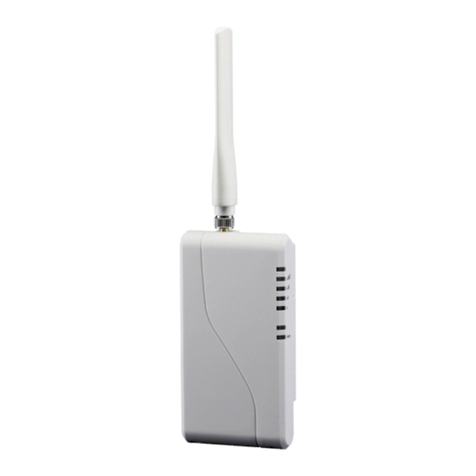
Telguard
Telguard TG-1 Express CDMA User manual

Telguard
Telguard TG-7 Series Installation guide
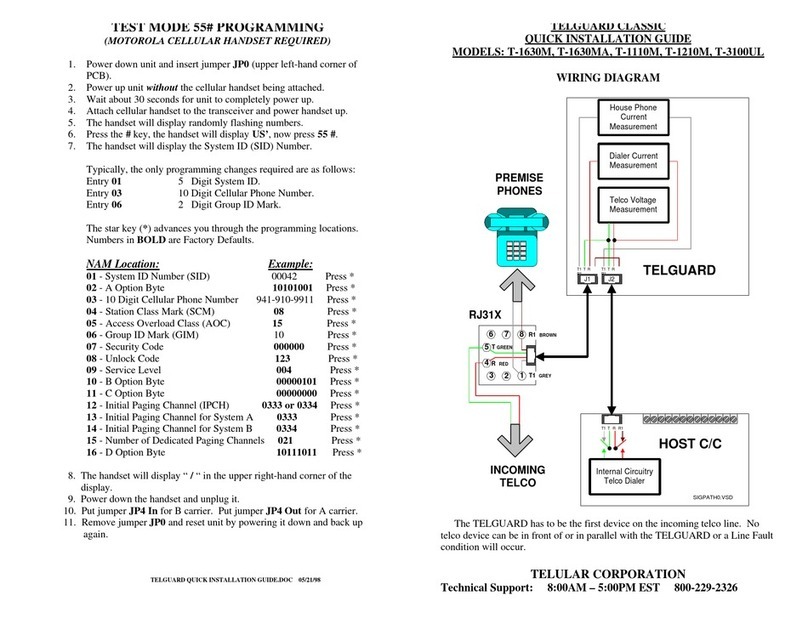
Telguard
Telguard T-1630M Classic User manual
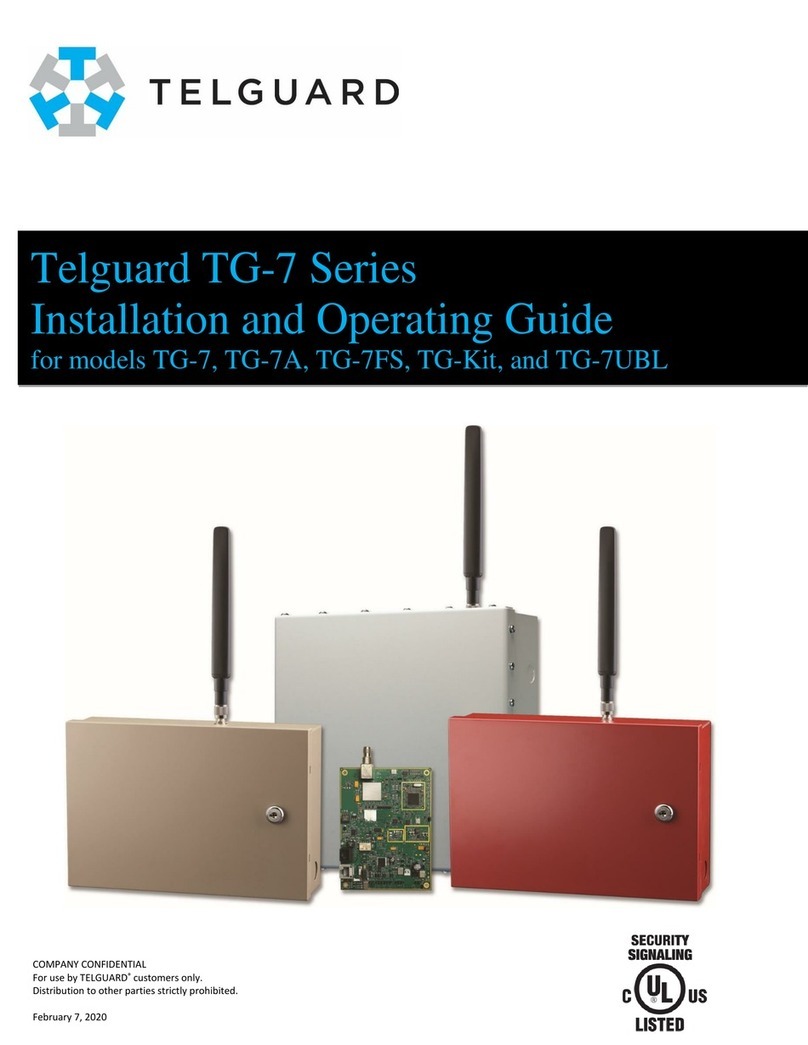
Telguard
Telguard TG-7UBL Installation guide
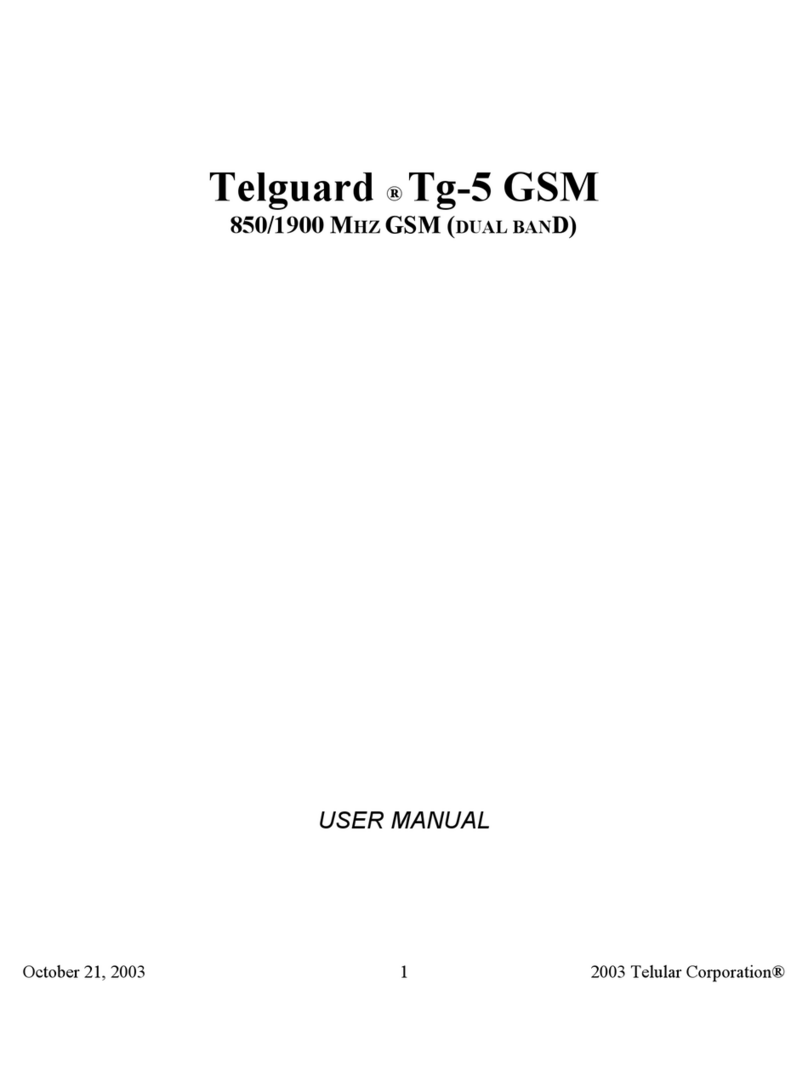
Telguard
Telguard Tg-5 GSM User manual
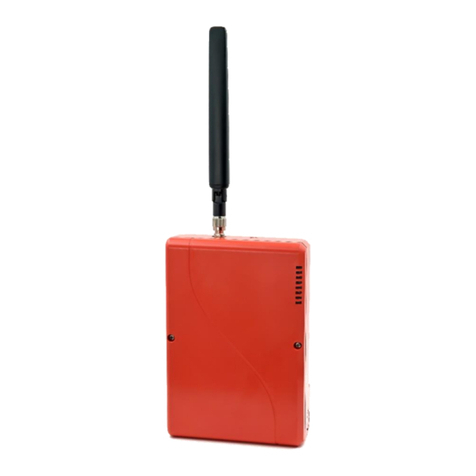
Telguard
Telguard TG-7FP Original operating instructions

Telguard
Telguard TG-4 User manual

Telguard
Telguard TG-7 Series Installation guide
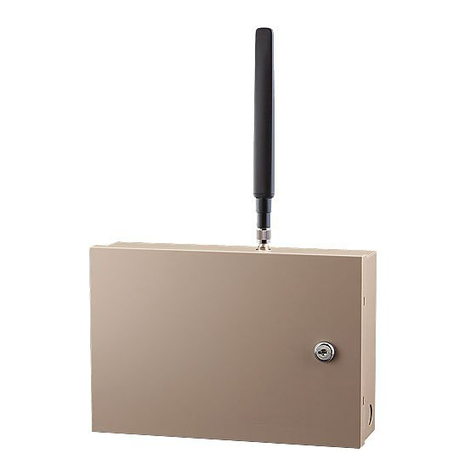
Telguard
Telguard TG-7A Installation guide

Telguard
Telguard TG-7FP Original operating instructions
